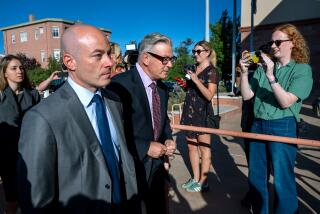Nearly 750 hours of video and 2,000 calls to 911 in Vegas shooting. Almost all of it remains unseen and unheard

The Los Angeles Times and other media outlets have gone to court in an effort to get Las Vegas police to release the hundreds of hours of 911 calls and body camera footage recorded during the Oct. 1 shooting rampage.
- Share via
Reporting from Las Vegas — The footage looks unremarkable — a balding man sitting slouched at a video poker machine. The same man walking in a hallway with luggage on a carrier. Riding in an elevator. Eating alone.
Unremarkable except that the figure in the video was Stephen Paddock, the man who ultimately settled in on the 32nd floor of the Mandalay Bay Resort and Casino and opened fire down below at the Route 91 Harvest country music festival on the night of Oct. 1, killing 58 people and wounding hundreds of others.
Released by MGM International Resorts, it was just one more glimpse into the largest mass shooting in modern American history. But hundreds of hours of 911 calls and body-camera footage from police during the rampage remain unreleased.
The Las Vegas Metropolitan Police Department has fought the release of those items in court for months — much as they fought the unsealing of search warrants related to Paddock after the shooting. State and federal judges ultimately ruled against the department and ordered hundreds of pages of search warrants be unsealed.
Last week, as MGM released its security camera footage and still images of Paddock, lawyers for Las Vegas police were arguing in court against the request of media outlets — including the Los Angeles Times — for police body-camera footage and 911 recordings made the night of the shooting.
The tug of war has resulted in police asking for — and being granted — a new judge to hear the case after another judge ordered the release of the requested items. In the meantime, the material — except for some edited video that was released days after the shooting — remains off-limits to the media.
Jackie Nichols, a lawyer for the police department, wrote in her brief last week that District Court Judge Richard Scotti’s March 2 ruling was “clearly erroneous because the government’s interest in non-disclosure significantly outweighs any interest the public has in access.”
The department, when ordered to comply with the public records requests, also cited a heavy toll on manpower and said reproducing the records would be a burdensome endeavor. According to the department, there is almost 750 hours of body-camera footage that would require review and the redaction of some items, a process that could take as long as six months to complete.
There were also 2,000 calls related to the shooting, police said, and the department has only three analysts qualified to oversee redactions on 911 calls. The department also argued in briefs that the material is “extremely graphic and it is against LVMPD policy to assign a single person to review.”
Police department lawyers estimate there are also 1,500 documents related to the shooting. According to the brief, the department said “these documents will likely contain personal information that will require redaction. Like much of the other information requested, this will require employees to review and redact personal, identifiable information, requiring significant use of personnel.”
Police said the cost could approach $500,000 to provide copies of all the material — a figure Scotti dismissed as unreasonable.
Barry Smith, executive director of the Nevada Press Assn., said it was hard to see how police could argue there wasn’t compelling interest in the largest mass shooting in modern American history. Further, he said, there isn’t an active investigation by Las Vegas police, given that Paddock killed himself in the hotel room.
“That is really the only excuse for withholding any information or delaying its release — an active investigation,” Smith said. “Even then, you should make some argument beyond that why the release of the information will hurt you and that isn’t a line of thinking we get to see. In this case, there appears to be zero reason for withholding any public information.”
Justin Shiroff, one of the attorneys arguing for the release of court records and representing media clients — including the Los Angeles Times — argued Friday at a hearing before District Court Judge Stefaney Miley that there are items within police records that aren’t controversial, could be easily turned over and that releasing that material should start immediately.
MGM Resorts, in a statement, said it decided to release its security camera footage last week “in the interest of providing greater context around Stephen Paddock’s actions in the days leading up to October 1.”
“As the security footage demonstrates, Stephen Paddock gave no indication of what he planned to do and his interactions with staff and overall behavior were all normal,” MGM spokeswoman Debra DeShong wrote. “MGM and Mandalay Bay could not reasonably foresee that a longtime guest with no known history of threats or violence and behaving in a manner that appeared outwardly normal would carry out such an inexplicably evil, violent and deadly act.”
Craig Eiland, an attorney representing several victims in the shooting, said the video footage provided valuable information — that there weren’t enough security measures in place.
“There was no attempt to smuggle his assault weapons, because it wasn’t necessary. He was open and obvious,” Eiland said in an email. “He knew that Mandalay Bay wasn’t looking, therefore, they wouldn’t find his 21 assault rifles or ammunition. No security system, no detection, no training. There are red flags throughout the video.”
With the volume of mass shootings in recent years, it’s been a mixed bag in terms of how long it takes for police departments to release 911 calls of video footage.
After the Pulse nightclub shooting in Orlando, Fla., police were sued for the release of 911 calls, and it took a court order to make them public about five months after 49 people were killed in 2016.
In Newtown, Conn., 911 calls were made public almost a year after the 2012 massacre that left 26 people dead at Sandy Hook Elementary School.
In both cases, neither shooter survived — though Noor Salman, the wife of Omar Mateen, is currently standing trial on charges she aided her husband in the Pulse attack.
In Aurora, Colo., where James E. Holmes killed 12 people at a movie theater in 2012, the 911 calls were public in just more than a week. Holmes survived and stood trial.
Last month, when 17 people were killed at Marjory Stoneman Douglas High School in Parkland, Fla., 911 calls and surveillance video were released about three weeks later, though an attorney representing the media said he was not convinced all the surveillance video had been released. The Parkland shooter was taken into custody and is awaiting trial.
Interest in the information was high, and arguments for not releasing it came down to whether the material would present a danger to law enforcement by exposing tactics and techniques or assist in providing tools for how to improve responses to such tragedies.
The next court hearing for the release of 911 calls and body-camera footage in Las Vegas is set for late April — six months after the shooting.
Twitter: @davemontero
More to Read
Sign up for Essential California
The most important California stories and recommendations in your inbox every morning.
You may occasionally receive promotional content from the Los Angeles Times.














